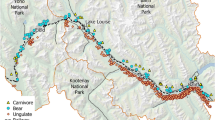Abstract
Potential environmental impacts on wildlife result from siting and construction (short-term impacts) and habitat removal and fragmentation (long-term impacts) as a consequence of transportation corridor construction. Especially in rural districts, wildlife migration corridors and dispersal orientation are altered or destroyed and wildlife populations and their gene pools are isolated. This significantly weakens the wildlife community. Prudent selection of construction corridors reduces fragmentation impacts by maximizing preserved fragment sizes, and by running parallel to, not through, natural areas. Corridor width determines the degree to which wildlife movement is restricted except that culverts, underpasses, overpasses, and one-way gates, can aid wildlife in cross movements. Minimum underpass dimensions for large wildlife should be no smaller than 14 ft×14 ft and should include natural substratum inverts. Rail corridors have four characteristics that minimize adverse environmental impacts. The railbed is dry, ballast fillters runoff, there is little runoff beyond the toe of slope, and drainage ditches serve to control sheet flow and erosion, sediment movement, and uncontrolled channel flow. Rail corridors usually occupy smaller land areas because they are narrower and are more feasible to elevate so as to allow free movement of wildlife across the corridor.
Similar content being viewed by others
Literature Cited
Ambul, B., and S. A. Temple. 1983. Area-dependent changes in the bird communities and vegetation of southern Wisconsin forests.Ecology 64:1057–1068.
AASHTO (American Association of State Highway and Transportation Officials). 1976. A design guide for wildlife protection and conservation for transportation facilities. Washington, DC.
Beecher, W. J. 1942. Nesting birds and the vegetation substratum. Chicago Ornithological Society, Chicago.
Burgess, R. L., and D. M. Sharpe. 1981. Forest island dynamics in man-dominated landscapes. Springer-Verlag, New York.
Chasko, G. G., and J. E. Gates. 1982. Avian habitat suitability along a transmission-line corridor in an oak-hickory forest region.Wildlife Monographs 88:1–41.
De Santo, R. S. 1978. Concepts of applied ecology. Springer-Verlag, New York, 310 pp.
Erickson, P. A., and G. Camougis. 1980. Highways and wetlands, Volume II, Impact assessment, mitigation and enhancement measures. Federal Highway Administration, Technical Report PB81-242091.
Erickson, P. A., G. Camougis, and E. G. Robbins. 1978. Highways and ecology: Impact assessment and mitigation. Federal Highway Administration, Washington, DC.
Falk, J. A., and D. F. Stauffer. 1988. Methods for measuring landscape fragmentation of raptor habitat. Pages 162–170in Northeast Raptor Management Symposium and Workshop. National Wildlife Federation Scientific and Technical Series No. 13.
Forman, R. T. T., A. E. Galli, and C. F. Leck. 1976. Forest size and avian diversity in New Jersey woodlots with some land use implications.Oecologia 26:1–8.
Forman, R. T. T., A. E. Galli, and C. F. Kecj, 1981. Patches and structural components for a landscape ecology.Bioscience 31:733–740.
Galli, A. E., C. F. Leck, and R. T. T. Forman. 1976. Avian distribution patterns in forest islands of different sizes in central New Jersey.Auk 93:356–364.
Harris, L. D. 1984. The fragmented forest. University of Chicago Press, Chicago, 211 pp.
Hill, D. B. 1985. Forest fragmentation and its implications in central New York.Forest Ecology and Management 29:33–37.
Leedy, D. L. 1975. Highway-wildlife relationships, Volume 1, A state-of-the-art report. Federal Highway Administration. Washington, DC.
Leedy, D. L., and L. W. Adams. 1982. Wildlife considerations in planning and managing highway corridors. Federal Highway Administration. Washington, DC.
Lynch, J. F., and D. F. Whigham. 1984. Effects of forest fragmentation on breeding bird communities in Maryland, USA.Biological Conservation 28:287–324.
Naveh, Z., and A. S. Lieberman. 1984. Landscape ecology—theory and application. Springer-Verlag, New York, 356 pp.
Odum, E. P. 1971. Fundamentals of ecology, 3rd ed. W.B. Saunders, Philadelphia, 574 pp.
Opdam, P., G. Rysdijk, and F. Hustings. 1985. Bird communities in small woods in an agricultural landscape: Effects of area and isolation.Biological Conservation 34:333–352.
Reed, D. F. 1981. Mule deer behavior at a highway underpass exit.Journal of Wildlife Management 45:542–543.
Reed, D. F., T. M. Pojar, and T. N. Woodard. 1974. Use of one-way gates by mule deer.Journal of Wildlife Management 38:9–15.
Reed, D. F., T. N. Woodard, and T. M. Pojar. 1975. Behavioral response of mule deer to a highway underpass.Journal of Wildlife Management 39:361–367.
Robbins, C. S. 1979. Effects of forest fragmentation on bird populations. Pages 198–212in R. M. Degraaf and K. E. Evans (eds.), Management of north central and northeastern forest for nongame birds. US Department of Agriculture, Forest Service General Technical Report NC-51.
Singer, F. J. 1978. Behavior of mountain goats in relation to US Highway 2, Glacier National Park, Montana.Journal of Wildlife Management 42:591–597.
Singer, F. J., and J. L. Doherty. 1985. Managing mountain goats at a highway crossing.Wildlife Society Bulletin 13:469–477.
Whitcomb, R. F. 1977. Island biogeography and “habitat islands” of eastern forests.American Birds 31:3–5.
Whitcomb, R. F., C. S. Robbins, J. F. Lynch, M. K. Klimkiewicz, B. L. Whitcomb, and B. Bystrak. 1981. Effects of forest fragmentation on avifauna of the eastern deciduous forest,in R. L. Burgess and D. M. Sharpe. Forest island dynamics in man-dominated landscapes. Springer-Verlag, New York.
Author information
Authors and Affiliations
Rights and permissions
About this article
Cite this article
De Santo, R.S., Smith, D.G. An introduction to issues of habitat fragmentation relative to transportation corridors with special reference to high-speed rail (HSR). Environmental Management 17, 111–114 (1993). https://doi.org/10.1007/BF02393799
Issue Date:
DOI: https://doi.org/10.1007/BF02393799



